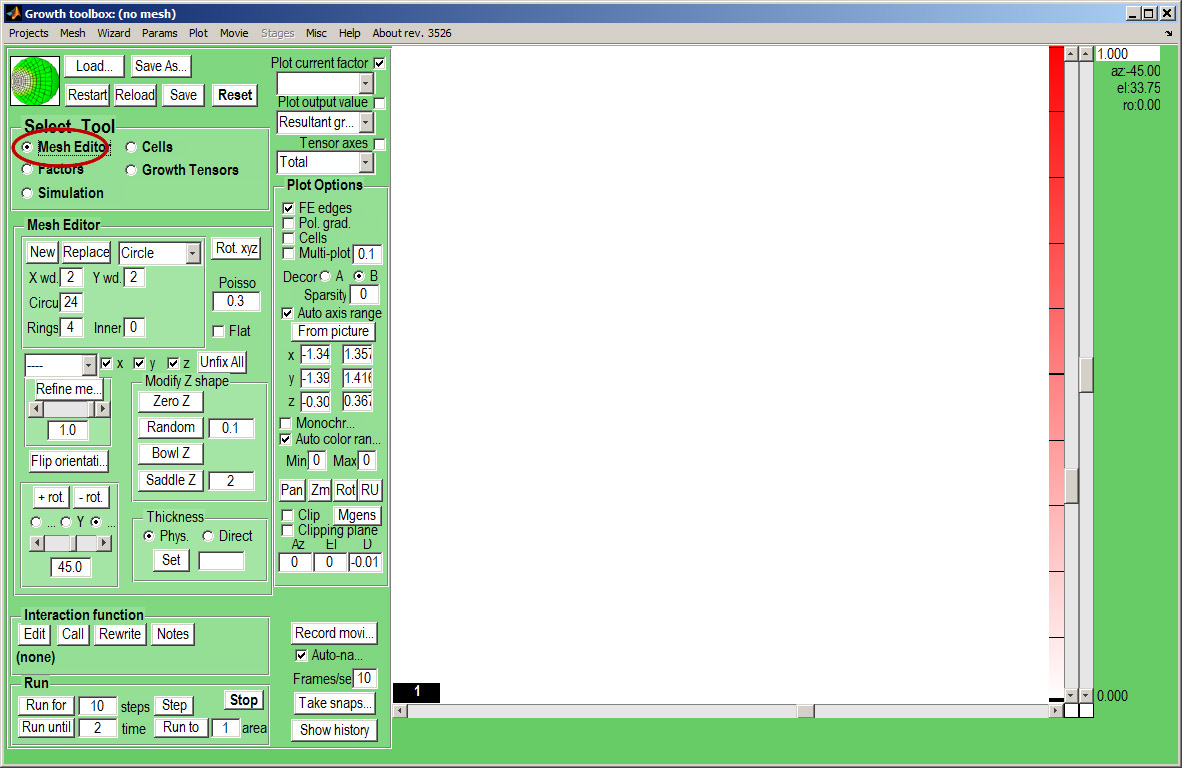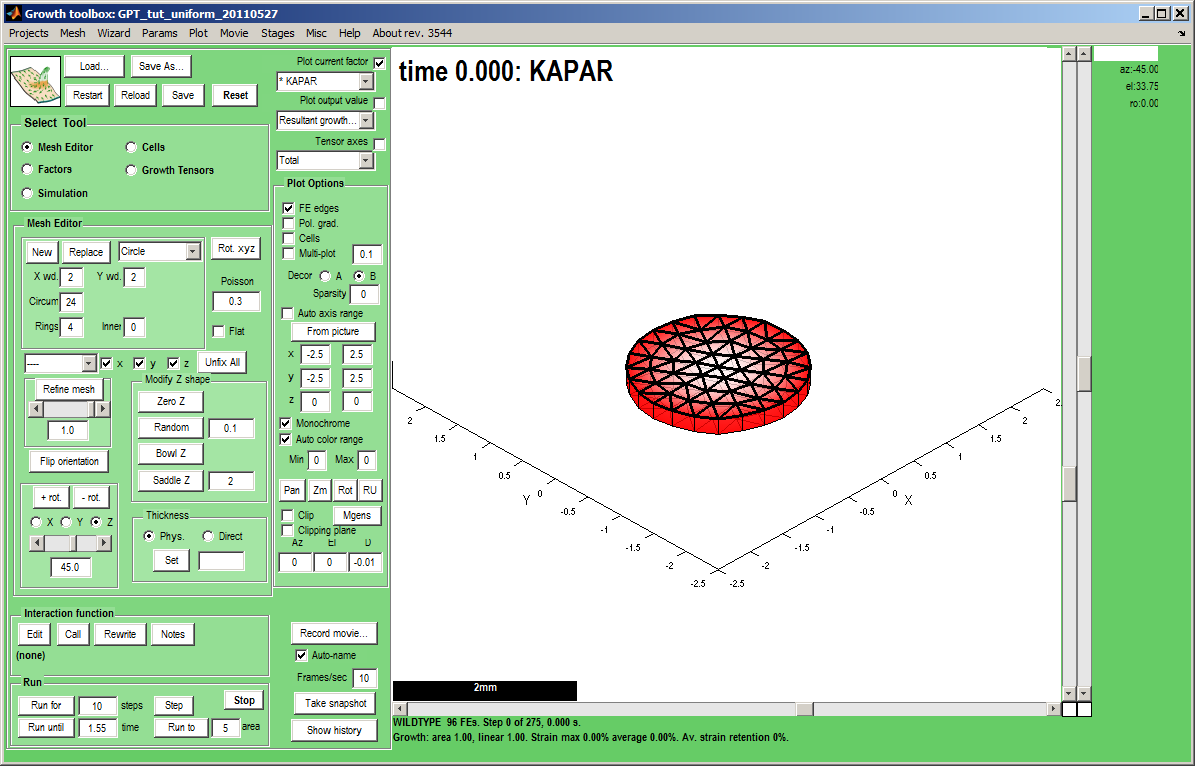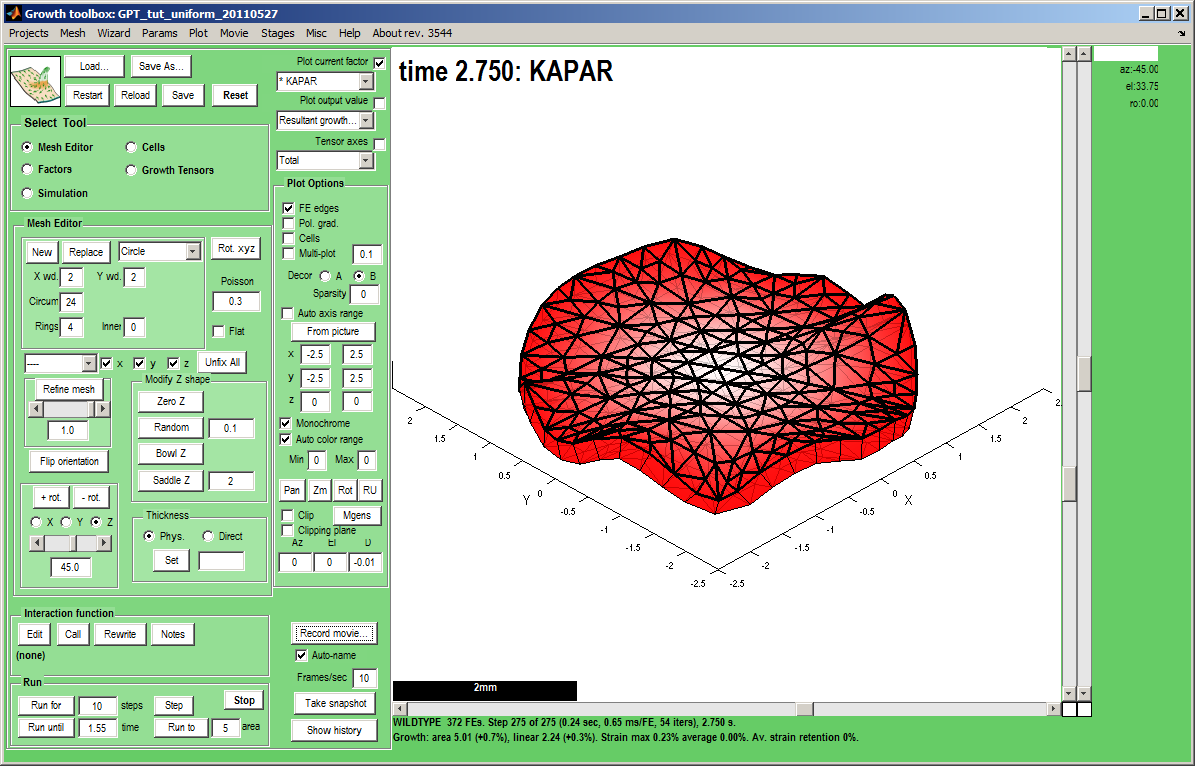In the beginning non-uniform: Difference between revisions
Jump to navigation
Jump to search
No edit summary |
No edit summary |
||
| (2 intermediate revisions by the same user not shown) | |||
| Line 20: | Line 20: | ||
|- valign="top" | |- valign="top" | ||
|width="300px"|''Select Tool:Factors'' makes the ''Morphogen'' Panel visible. Currently we are controlling the ''KAPAR'' factor. It has been selected from a drop down list top right (''Plot current factor''). We add a radially increasing gradient of ''KAPAR''. Make sure that the ''Panel Plot Options:Monochrome'' is ticked and the gradient of ''KAPAR'' will be as shown. Do the same for the top face, KBPAR. <br><br> | |width="300px"|''Select Tool:Factors'' makes the ''Morphogen'' Panel visible. Currently we are controlling the ''KAPAR'' factor. It has been selected from a drop down list top right (''Plot current factor''). We add a radially increasing gradient of ''KAPAR''. Make sure that the ''Panel Plot Options:Monochrome'' is ticked and the gradient of ''KAPAR'' will be as shown. Do the same for the top face, KBPAR. <br><br> | ||
'''What will be the result of growth on just the bottom side of the canvas, KAPAR?''' | '''What will be the result of growth on just the bottom side of the canvas, KAPAR?'''<br><small>Note: the different ways to fix the levels of morphogens - 'Add constant', 'Add random', 'Add to rim', 'Add radial' centred on x,y,z position, 'Add linear'. In addition, if Panel: Plot Options: FE edges is ticked to reveal the mesh, clicking on a node will add the specified amount (slider) to that node alone. To set values (as opposed to adding) use 'Set zero' or select 'Set' in the list box. <br><br>Colours are set by clicking on the colour boxes.</small> | ||
|width="500px"|[[File:tut_non_uniform_growth_initial.png|500px|GFtbox interface]] | |width="500px"|[[File:tut_non_uniform_growth_initial.png|500px|GFtbox interface]] | ||
|} | |} | ||
| Line 32: | Line 32: | ||
Idea: set the axes manually (here to +-3) and turn off Panel:Plot Options: Auto axis range and Menu:Plot:Auto zoom and centre. This enables growth to be seen as a change of size rather than change of axis range. | Idea: set the axes manually (here to +-3) and turn off Panel:Plot Options: Auto axis range and Menu:Plot:Auto zoom and centre. This enables growth to be seen as a change of size rather than change of axis range. | ||
Idea: take a snapshot of the canvas by pressing Take snap... (c.f. image on right, button is bottom right of GUI controls)<br> | Idea: take a snapshot of the canvas by pressing Take snap... (c.f. image on right, button is bottom right of GUI controls)<br> | ||
Idea: to create an uncompressed movie of your simulation, before running click the ''Record movie'' and when it is finished click ''Stop movie''. The movie will be in the Project directory. | Idea: to create an uncompressed movie of your simulation, before running click the ''Record movie'' and when it is finished click ''Stop movie''. The movie will be in the Project directory. Compressors can be selected using the Menu: Movie: Codec option and the result can be converted to a flash movie (for the web) by Menu: Movie: Convert to flash this, however, requires ffmpeg to be installed on the computer.</small> | ||
|width="500px"|[[Image:tut_non_uniform_growth_final.png|500px|GFtbox interface]] | |width="500px"|[[Image:tut_non_uniform_growth_final.png|500px|GFtbox interface]]Extra growth around the perimeter introduces Gaussian curvature. The canvas is readily able to distort out the plane because it started out with a small amount of random noise in the Z direction. (If the canvas started perfectly flat, residual strain (stress) would build up at each step rather than the surface distorting to accommodate the extra growth.) | ||
|} | |} | ||
Latest revision as of 11:04, 3 June 2011
Back to Tutorial pages
We start with a number of very large screenshots (don't be daunted they are just here to orient you). They show the GFtbox graphical interface.
Modelling non-uniform growth using the GUI alone
First view
| The GFtbox user interface. Focus on the Select Tool Panel. Here the Mesh Editor has been selected and the Mesh Editor panel is visible.
|

|



